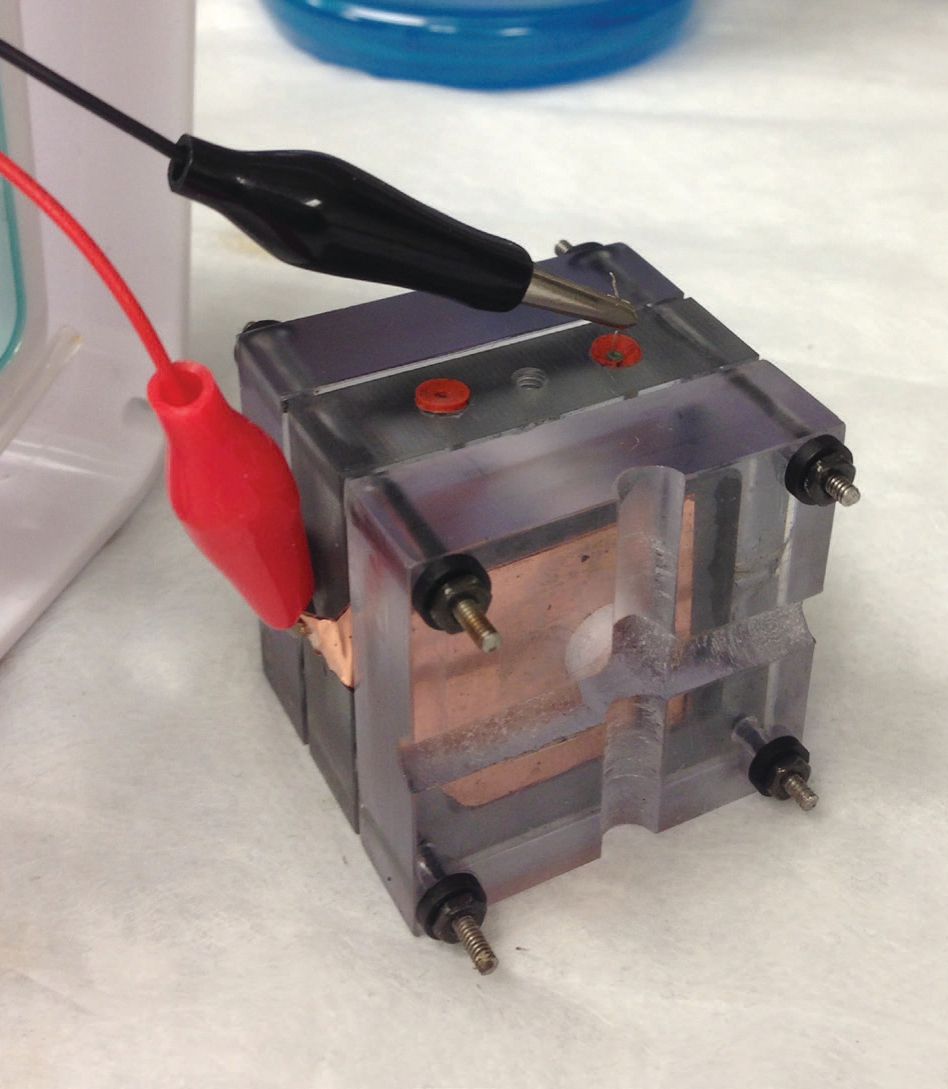Room temperature biofuel cell
Dr. Neil Canter, Contributing Editor | TLT Tech Beat February 2015
A newly developed enzymatic process converts the hydrocarbons in the jet fuel JP-8 into useful energy.
KEY CONCEPTS
•
A biofuel cell using an enzyme cascade has been developed that, for the first time, converts hydrocarbons into useful energy at room temperature.
•
Power densities as high as 3 milliwatts per square centimeter were achieved with the biofuel cell.
•
In using a hydrocarbon based jet fuel known as JP-8, the biofuel cell works even in the presence of sulfur, which can poison conventional fuel cells.
INTEREST IN FUEL CELLS CONTINUES TO GROW as automotive manufacturers are commercializing vehicles that use them. Toyota will start selling a fuel cell vehicle in April in Japan, followed by four manufacturers initiating sales in California during the summer.
Traditional fuel cells produce energy through the reaction of hydrogen with oxygen from the air to produce water using a platinum catalyst. One issue hindering the growth of fuel cell-powered automobiles is the need for hydrogen fueling stations.
A previous TLT article examined a new test-meter facility developed to measure the flow of hydrogen gas into automobiles (
1). The facility can accurately evaluate test meters under pressure and temperature transients that would occur from a 35-megapascal gaseous dispenser without any gaseous dispensers.
Hydrogen is not the only fuel that can be used to power fuel cells. A kerosene-based jet fuel known as JP-8 is widely used by the military because it can operate over a wide temperature range from extreme cold to hot weather conditions and is not as flammable as other alternatives. Shelley Minteer, a USTAR professor of chemistry and material science and engineering at the University of Utah in Salt Lake City, Utah, says, “JP-8 is a more complex fuel than hydrogen, and past attempts to generate energy using solid oxide fuel cells which operate at high temperatures above 500 C were not successful. One problem with using this fuel cell type is the metal catalysts used are poisoned by the presence of sulfur in JP-8.”
The sulfur content of JP-8 can range from 400 to 1600 ppm. Installation of a reformer into the fuel cell to convert the jet fuel into hydrogen is possible, but it adds complexity and weight to the fuel cell, according to Minteer.
An alternative to conventional fuel cells that primarily use platinum or platinum alloys as a metal catalyst is a biofuel cell. Minteer says, “Biofuel cells use a biocatalyst to convert fuel into energy. The biocatalyst can be as specific as an enzymatic protein or as general as a microbe or an organelle. Enzymes are desired, because they are higher in volumetric activity since a microbe cell can take up more space.”
Biofuel cells do have some limitations. Minteer says, “The biggest problem with biofuel cells is the denaturing of the enzyme catalyst. In general, biofuel cells cannot be operated above a temperature of 45 C or the enzymes will denature and no longer be capable of catalyzing the oxidation reaction. Working with JP-8 is also a challenge because most fuels used are sugars such as sucrose, glucose and fructose. JP-8 adds complications because it contains not just one hydrocarbon but a mixture of hydrocarbons.”
If a suitable enzyme can be found, then there is the potential for developing a biofuel cell that operates at low temperature. Such a biofuel cell has now been developed.
ENZYME CASCADE
Minteer and her associates have now developed an enzyme cascade that will convert JP-8 into useful energy needed to power a biofuel cell at room temperature. The enzymatic process involves converting the hydrocarbons in JP-8 first to alcohols through the use of the enzyme alkane monooxygenase (AMO) followed by the use of alcohol oxidase (AOx) to transform the alcohols into aldehydes.
One of the reasons for the success of this process is that the enzymes used act in a promiscuous fashion. Minteer explains, “Promiscuous enzymes have the ability to react with the same functional group (such as a hydroxyl group) on multiple substrates no matter the position of the specific group. This enzyme type is used by simple microbes because it gives them the flexibility to react with a variety of substrate molecules.”
In contrast, most mammalian enzymes are very well evolved, according to Minteer, and can only be used in a specific situation because they follow the ‘lock and key’ model. But this type of enzyme is unsuitable for a biofuel cell because it will not work on multiple substrates such as the hydrocarbon mixture found in JP-8.
The researchers prepared the biofuel cell by casting an enzymatic ink containing the enzymes and a polymeric binder onto carbon paper to form the anode. A Prussian Blue cathode containing an ionic liquid was used as the other electrode in the biofuel cell. Figure 3 shows an image of the biofuel cell.
 Figure 3. This is the first biofuel cell able to convert hydrocarbons into useful energy at room temperature. Figure courtesy of the University of Utah.
Figure 3. This is the first biofuel cell able to convert hydrocarbons into useful energy at room temperature. Figure courtesy of the University of Utah.
Initial work was done to test the enzyme cascade with specific hydrocarbons for the first step and alcohols for the second step. The primary chain lengths used were C6 and C8, the major components in JP-8. Testing to evaluate the ability of the enzyme cascade to handle sulfur was done by adding sulfate at a sulfur concentration similar to what is seen in JP-8. No reduction in enzymatic activity was detected.
The biofuel cell was able to oxidize JP-8 successfully at room temperature and produced power densities as high as 3 milliwatts per square centimeter without removing sulfur from the fuel. This success was achieved even though the two main enzymes used, AMO and AOx were not in close proximity to each other. AMO was in solution and AOx was immobilized on the anode. Minteer says, “One of the future objectives we have is to position both of these enzymes as close to together as possible to improve efficiency. This can be very difficult because enzymes tend to aggregate, which can lead to a reduction in performance.”
Another concern is that hydrogen peroxide is produced in the second step of the enzyme cascade. Minteer says, “We may need to add a deperoxidation process as a third step in the future or chose an alcohol oxidizing enzyme that does not produce peroxide.”
For the first time, researchers have proven that the biofuel cells works on hydrocarbons. Minteer says, “We will now need to optimize the system and then evaluate its stability in the future.”
Additional information can be found in a recent article (
2) or by contacting Minteer at
minteer@chem.utah.edu.
REFERENCES
1.
Canter, N. (2014), “Testing meters used to dispense hydrogen fuel,” TLT,
70 (10), pp. 15-16.
2.
Ulyanova, Y., Arugula, M., Rasmussen, M., Pinchon, E., Lindstrom, U., Singhal, S. and Minteer, S. (2014), “Bioelectrocatalytic oxidation of alkanes in a JP-8 enzymatic biofuel cell,”
ACS Catalysis,
4 (12), pp. 4289-4294.
 Neil Canter heads his own consulting company, Chemical Solutions, in Willow Grove, Pa. Ideas for Tech Beat items can be sent to him at neilcanter@comcast.net
Neil Canter heads his own consulting company, Chemical Solutions, in Willow Grove, Pa. Ideas for Tech Beat items can be sent to him at neilcanter@comcast.net.